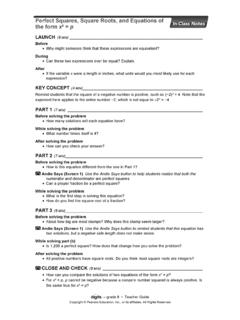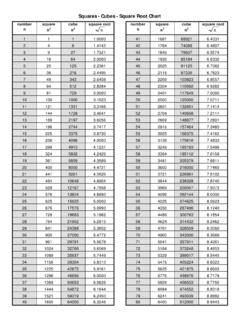Transcription of LESSON PLAN (Linda Bolin) - enetlearning.org
1 LESSON PLAN (Linda Bolin) LESSON Title: Squares, square Roots and Exponential Expressions Course: Pre-Algebra Date October LESSON 5 Utah State Core Content and Process Standards: , Recognize the inverse operation of computing squares of whole numbers and taking the square roots of perfect squares. Simplify numerical expressions with whole number exponents LESSON Objective(s): Identify the inverse of a square or square root . Write expressions in exponential form. Evaluate exponential expressions Enduring Understanding (Big Ideas): Exponential expressions model real world situations Essential Questions: How is n different from 2n, n different from 3n?
2 How is n related to n How can I simplify exponential expressions Skill Focus: writing and evaluating exponential expressions Vocabulary Focus: base, power, exponent, square number, square root , cube, exponential form, exponential expression Materials: Color Tiles (25 for each team) Foldable Perfect square and square Roots (two sided) Linker Cubes (100 for each team) Operations and Exponents , Exponential Expressions TI-73 graphing calculators Assessment (Traditional/Authentic): performance task, writing Ways to Gain/Maintain Attention (Primacy): cooperative group, technology, manipulatives, writing in journal, game Written Assignment: Building Squares and square Roots and Foldable for journal Operations and Exponents Sketches and representations for manipulatives work and record for game Building Exponential Expressions Exponential Expressions Journal Page Content Chunks Starter: Find the answers Circle the expression(s) or model with the greatest value in each problem below.
3 1. 2 19 19 + 19 19 2. 7 + 7 7 7 7 3. 5 + 5 5 5 5 4. 3 x 3 3 + 3 LESSON Segment 1: How is n related to n ? How is n different from 2n? How is n different from 3n? Use Building A square Patio (attached), an investigation with Color Tiles to help students visualize the inverse relationship between squaring a number and taking the square root of that perfect square . Student pairs or teams can build each patio using the Color Tiles.
4 Discuss each step as a class focusing on the relationship between the side length and the root , between the square and total tiles, and between the root and the square . Briefly review with students how to write a base number and an exponent. Students have used this notation since 5th grade. Show students how to use the 6 or 7 keys on a Ti-73 to write exponential expressions. Have them use the calculator and the attached Foldable Perfect Squares and square Roots to build a table of values. Copy the foldable to make two sided page that will be folded in thirds on the dotted line.
5 Have students work with partners to complete the investigation, Operations and Exponents . Discuss possible answers to question # 4 and 5 on the investigation. Handout the journal page for exponents (attached). LESSON Segment 2: What are some real-world applications for exponential notation? How is n related to n ? Follow the instructions on the attached activity Building Exponential Expressions With Color Tiles and Linker Cubes to help students broaden their understanding and see real-world application. Complete the Journal Page. LESSON Segment 3: Practice and application Journal: Do Mix-Freeze-Pair where students mix around the room until you say freeze.
6 They find the person closest to them to be their partner. If no partner is immediately available, they raise their hand high and look for someone else with hand raise high. During this activity, you will model an example or two for each of the vocabulary words on the journal page and for items 1-4. Use the graphing calculator to show examples. Then you will have the students use their TI-73 s to give an example to their partner, or you will give them an example and they will supply the vocabulary word for it. Students should mix and find a new partner for each of the words.
7 The links on the District Math Page have some great examples of where exponents are used in the real world. Area, Volume, Scientific Notation, Biology, Astronomy, earthquake (Richtor Scale). You may want to assign students to find a real world example to bring to class. Game: Playing With Powers Two players take turns rolling two dice and deciding which to use as a base and which to use as an exponent. After five turns, the players find the sum of the five exponential expressions they created. Player with the greatest sum, wins. Assign students the attached Exponential Expressions practice attached, or appropriate text items.
8 Building Squares and square Roots Name_____ With Color Tiles Use Color Tiles to build each consecutive square . Write the expression for each cell in the table. Use the table below to organize your data. Then, use the patterns to answer the questions. Sketch Length Find total Find total using Find length of a side of side Squares an exponent using a square root 1" 1 1 = 1 1 = 1 1 = 1 2" 3" 4" 5" n 1. How many total tiles would there be if the length of the side of the square was 6?
9 2. What would the length of the square s side (the square root ) have to be if there were 49 total tiles in the area? 3. If you knew the length of a side was 10, explain how you would find the total number of squares. 4. Explain how you would find the length of the side of the square patio, if you knew the total number of tiles was 64. 5. There is an inverse relationship between squaring a number and taking the square root of that perfect square . Explain what this means. Find the value for each: 6) 12 7) 8 8) 169 9) 10 n n n 1 1 = 1 1 = 1 2 2 = 4 4 = 2 3 3 = 9 9 = 3 To square a number To find a square root means to.
10 Of a number means: Operations and Exponents Name _____ 1. Circle the two expressions in each of the following sets that have the same answer? A. 1 + 1 + 1 + 1= 1 1 1 1 = 1 x 4 = B. 2 + 2 + 2 + 2 + 2 = 2 x 5 = 2 2 2 2 2 = C. 8 8 8 = 8 + 8 + 8 = 8 x 3 = D. 14 = 1 1 1 1 = 1 x 4 E. 8 + 8 + 8 = 8 8 8 = 83 F. 2 x 5 = 2 + 2 + 2 + 2 + 2 = 25 2. Which is equal to 63: 6 + 6 + 6 or 6 6 6 ?












